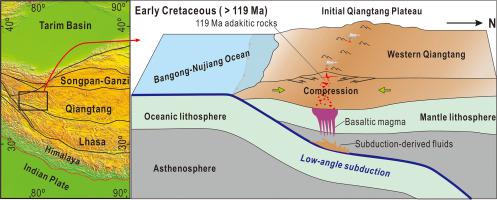Lithos ( IF 3.5 ) Pub Date : 2021-03-17 , DOI: 10.1016/j.lithos.2021.106117 Qiang Ke , Tao Hong , Xing-Wang Xu , Hao Li , Xiao-Xue Tong , Lian-Hui Dong , Ting-Bin Fan , Hang Li , Yu-Hao Li

|
Felsic igneous rocks in the Songxi area are a key part of the Qiangtang Terrane and India–Asia collision zone, and can constrain the evolution of the Tibetan Plateau. This paper presents new geochronological, geochemical, and isotopic data for Early Cretaceous granodiorites (119 Ma), leucogranites (111 Ma), and monzogranites (107–102 Ma) from the Songxi area in the western Qiangtang Terrane. The granodiorites are characterized by enriched Sr–Nd–Pb–Hf isotopic compositions (87Sr/86Sri = 0.70721–0.70925, εNd(t) = −7.6 to −5.6, 206Pb/204Pbi = 18.907–18.964, 207Pb/204Pbi = 15.782–15.825, and εHf(t) = −24.0 to −2.0) and are adakitic with low Mg# values (39–44) and high K2O contents (2.6–3.9 wt%). The leucogranites have low Sr concentrations (80–100 ppm), high Rb/Sr (2.83–3.53) and low CaO/Na2O (0.19–0.22) ratios, high initial 87Sr/86Sr ratios (0.71653–0.71721), and low εNd(t) (−12.4 to −11.8) and εHf(t) (−18.8 to −6.8) values. The monzogranites are I-type granitoids and have enriched Sr–Nd–Pb–Hf isotopic compositions (87Sr/86Sri = 0.70956–0.70966, εNd(t) = −8.5 to −8.3, 206Pb/204Pbi = 18.740–18.749, 207Pb/204Pbi = 15.759–15.778, and εHf(t) = −16.9 to −1.4). Our data suggest that these three types of granitoids were likely generated by partial melting of a thickened lower crust, metapelite-dominated source by fluid-absent muscovite melting, and normal lower crust, respectively. Integration of our new and existing data allows us to conclude that the Songxi granitoids formed in a continental margin arc setting. This further suggests that some sediment-derived leucogranites form in a continental arc setting, and are unrelated to continental collision. Tectonic compression and crustal thickening of the western Tibetan Plateau during the Early Cretaceous occurred when the Bangong–Nujiang oceanic lithosphere was subducted northward at a low angle beneath the western Qiangtang Terrane before ca. 119 Ma.
中文翻译:

白垩纪早期青藏高原西部的地壳增厚:来自Terra塘地带西部松溪地区的adakitic花岗闪长岩,leucogranite和monzogranite的证据。
松溪地区的长石质火成岩是the塘地带与印亚碰撞带的关键部分,可以限制青藏高原的演化。本文介绍了Qian塘地带西部松溪地区早白垩世花岗闪长岩(119 Ma),亮花岗岩(111 Ma)和辉长岩(107-102 Ma)的新的地质,地球化学和同位素数据。的花岗闪长岩的特征在于富集锶的Nd-Pb的Hf同位素组合物(87 SR / 86锶我 = 0.70721-0.70925,ε的Nd(T)= -7.6到-5.6,206的Pb / 204铅我 = 18.907-18.964,207 Pb / 204 Pb i = 15.782-15.825,和ε的Hf(T)= -24.0至-2.0),并且埃达克与低Mg #值(39-44)和高K值2分O含量(2.6-3.9重量%)。无色花岗岩具有较低的Sr浓度(80–100 ppm),较高的Rb / Sr(2.83–3.53)和较低的CaO / Na 2 O(0.19–0.22)比,较高的初始87 Sr / 86 Sr比(0.71653-0.71721),和低ε的Nd(T)(-12.4至-11.8)和ε的Hf(T)(-18.8至-6.8)值。的monzogranites是I型花岗岩类丰富了锶的Nd-Pb的Hf同位素组合物(87 SR / 86锶我 = 0.70956-0.70966,ε的Nd(T)= -8.5到-8.3,206铅/ 204铅我 = 18.740-18.749,207的Pb / 204铅我 = 15.759-15.778,ε铪(t)=-16.9至-1.4)。我们的数据表明,这三种类型的花岗岩可能分别是由增厚的下地壳的部分熔融,缺少流体的白云母的熔融和变质的下地壳的部分熔融所产生的。综合我们的新数据和现有数据,我们可以得出结论,松溪花岗岩是在大陆边缘弧环境中形成的。这进一步表明,一些沉积物衍生的隐花花岗岩在大陆弧环境中形成,与大陆碰撞无关。当班公—怒江大洋岩石圈以低角度向北俯冲到Qian塘地带西部之前,向北俯冲时,发生在白垩纪早期青藏高原西部的构造压缩和地壳增厚。119毫安。


























 京公网安备 11010802027423号
京公网安备 11010802027423号